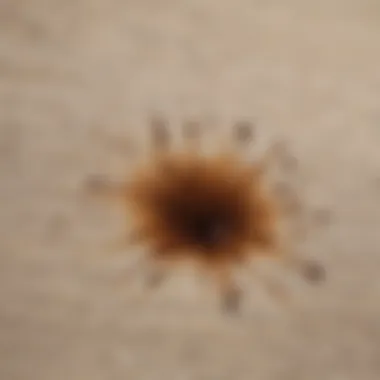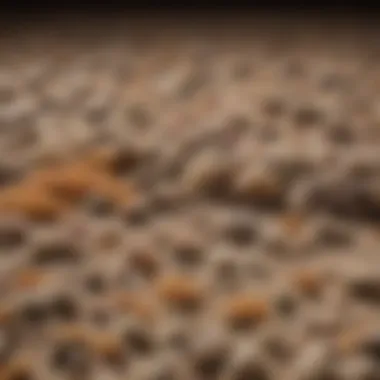Effective Techniques for Coffee Stain Removal


Intro
Coffee stains can be a real headache for homeowners. Just one spill, and suddenly, your once pristine carpet resembles a coffee shop floor after an energetic rush. Whether you’re a coffee aficionado or just someone who enjoys a morning brew, knowing how to tackle these stains is crucial for maintaining the beauty and integrity of your carpets.
In this article, we will delve into effective methods for erasing coffee stains, exploring both immediate responses when spills happen and longer-term strategies to keep your carpet looking its best. With a mix of practical tips and preventive guidance, this comprehensive guide is tailored for individuals who want to take control of their home environment.
Understanding the material makeup of your carpet can also inform the methods you choose to combat pesky stains. Not all carpets are created equal; some fibers react differently to various cleaning solutions. For instance, wool can be picky, while synthetic fibers might handle tougher treatments without a hitch.
Below, we’ll uncover the secrets behind successful stain removal, allowing householders to effortlessly restore their carpets to their original glory.
Key Insights and Trends
When it comes to interior design, the color palette and textures of carpets can play a pivotal role. Current trends highlight the move towards more vibrant colors and patterns, which can sometimes blur the lines when it comes to stain visibility. So, although a bold choice might catch the eye, it might also lead to anxious moments over unforgiving coffee spills. Here are some trends to consider:
- Muted Earth Tones: These colors can hide stains better than bright hues.
- Textured Carpets: Patterns can distract from occasional stain mishaps.
Stains are a reality in any busy household or workspace. Thus, knowing how to promptly and effectively address these messes is essential not just for aesthetics but also for prolonging the life of your flooring.
"Prevention is better than cure; setting the stage with smart choices at the outset can mitigate future mishaps."
Practical Tips and How-To Guides
Immediate Response to a Spill
- Act Fast: Time is of the essence. As soon as you notice that coffee has met your carpet, grab some paper towels or a clean cloth.
- Blot, Don't Rub: Gently blot the area to absorb as much liquid as possible. Rubbing can spread the stain or push it deeper into the fibers.
- Use Cold Water: Dampen a cloth with cold water, and continue blotting the area. This helps dilute the stain.
- Apply Cleaning Solutions: Consider using one of the following:
- Final Rinse: After treating the area, dampen a fresh cloth with plain water to remove any cleaning residue.
- White Vinegar Solution: Mix equal parts water and vinegar. Blot this solution on the stain.
- Dish Soap Mix: Combine a little dish soap with warm water and apply with a cloth.
- Store-Bought Cleaner: Use upward strokes with a product designed for carpets.
Preventive Measures
- Use Area Rugs: Strategically placed area rugs can absorb spills and minimize damage to your main carpet.
- Apply Stain Resistant Sprays: Consider treatments that protect against stains while still allowing for the carpet to breathe.
- Household Rules: Encourage coffee drinkers to be cautious and use lids or designate certain areas for sipping.
Being pro-active can save a lot of stress later on. Knowing how to effectively address coffee stains not only keeps carpets looking new but also adds to the overall ambiance of your home.
Understanding Coffee Stains
Understanding coffee stains is vital when it comes to preserving your carpet's aesthetic and lifespan. Coffee, a beloved beverage for many, has a dark side: its tendency to leave marks that are not only unsightly but can also become stubborn if not treated quickly. By grasping the characteristics of these stains, you can take informed steps to tackle them effectively.
The Chemical Composition of Coffee
Coffee is a blend of various compounds that contribute to its aroma and flavor. The primary culprits behind coffee stains are chromogens, which are pigments formed during the roasting process. These chromogens are what give coffee its deep brown color, making it quite a challenge when it comes to removal from fibers.
Additionally, coffee contains acids, oils, and sugars. When coffee is spilled, these elements interact with the carpet fibers, leading to deeper penetration and making stains tougher. The oils can exacerbate the issue by creating a greasy residue. Hence, knowing what you’re dealing with can aid in selecting the most suitable cleaning method, which is especially important as different materials react differently to various cleaning agents.
Why Stains Occur
Stains from coffee occur primarily due to two factors: composition and absorption. When coffee is serviced, it can immediately seep into the fibers of the carpeting, especially if the fibers are porous. This absorption is exacerbated if the coffee is hot, allowing it to penetrate even deeper.
Moreover, the timing of the spill greatly impacts the likelihood of a stain forming. If left sitting, the heat from the coffee and its sticky components will bond with the fibers, almost solidifying the stain. Understanding why coffee stains occur helps highlight the imperative nature of immediate action. Clean-up efforts should be swift to prevent the stain from becoming a permanent fixture in your carpet.
"The sooner you address a coffee spill, the better the outcome tends to be. Don’t let time turn your simple cleanup into a laborious task!"
In summary, recognizing the chemical components of coffee and the reasons behind its staining potential equips you with knowledge that can make all the difference in keeping your carpets looking fresh and new. Whether you’re entertaining guests or just enjoying a quiet moment at home, being prepared to deal with coffee stains means you can sip without a care in the world.
Immediate Actions to Take
When coffee makes its unwelcome mark on your carpet, time is of the essence. Immediate actions can significantly alter the battle between carpet fabric and that stubborn coffee stain. The quicker you spring into action, the better chances you have of avoiding a permanent blotch. This section dives into the essentials of acting swiftly and efficiently when faced with an unfortunate spill.
Acting Quickly
The moment you notice that splash of coffee on your carpet, your gut instinct might be to panic; however, keeping a cool head is paramount. In fact, acting quickly can mean the difference between a minor mishap and a major eyesore. Coffee contains tannins, which can penetrate the fibers of your carpet rapidly, leading to deeper stains as time goes on. So, the first step? Don’t just sit there—move!
Start by grabbing a clean cloth or paper towel. It’s important to have something on hand that is absorbent, yet soft enough to avoid damaging the carpet fibers. As you approach the stain, resist the urge to rub. Instead, think of it like blotting up blood; you want to absorb, not push that coffee deeper down.
Dabbing vs. Rubbing


When it comes to treating coffee stains, dabbing should be your go-to method. Let’s break it down:
- Dabbing involves gently pressing the cloth onto the stain. This is crucial because it absorbs the liquid without further spreading it, giving your carpet a fighting chance.
- Rubbing, on the other hand, might seem efficient at first. However, it often proves counterproductive, working that coffee deeper into the fibers and potentially creating fraying that is tough to repair.
Think of it like this: you wouldn’t scrub an open wound; you’d dab at it gently. The same principle applies here.
"An ounce of prevention is worth a pound of cure." Acting quickly can save your carpet from being rescue only by professionals.
Remember, keeping a few basic supplies at arm's reach can make these immediate actions easier:
- Absorbent Cloths: Microfiber towels are excellent for this task. They soak up a lot without leaving a mess behind.
- Paper Towels: Always handy, but be cautious not to use ones that might leave fibers behind.
- Clean Water: Rinsing well after dabbing removes residual coffee that could darken the stain later.
Taking these immediate steps creates a foundation for a successful cleaning process, ensuring that you've removed as much of that annoying stain as possible right from the get-go.
Gathering Cleaning Supplies
When facing the annoyance of coffee stains on your carpet, the first crucial step is gathering the right cleaning supplies. Having the appropriate tools and cleaners not only makes the process smoother but also enhances the chances of effective stain removal. Let’s explore why this step is vital and what items you’ll need to take on the task of restoring your carpet’s appearance.
Essential Tools
Before you dive headfirst into stain removal, let’s talk about the essential tools you'll need. Here’s a straightforward list that can prepare you for battle against those unsightly coffee spills:
- Absorbent Cloths or Paper Towels: These are your front line soldiers. Sturdy, soft materials are great for dabbing without pushing the stain deeper into the carpet fibers.
- Bucket: This acts as your supply station. Whether it’s for mixing cleaning solutions or rinsing, you’ll find a bucket quite handy.
- Spray Bottle: Perfect for applying cleaning solutions evenly on the stained area. A gentle mist is often better than a heavy pour.
- Soft-Bristled Brush: This is useful for addressing stubborn stains without damaging the carpet fibers.
- Vacuum Cleaner: A vacuum can help in the final cleanup after the stain has been treated, ensuring no residue is left behind.
Choosing the Right Cleaners
Now that you have your tools in hand, let’s zero in on selecting the right cleaners. Remember, not all cleaning solutions are created equal, especially when it comes to carpets.
- Mild Dish Soap: Simple and effective. This can be mixed with warm water to tackle the majority of coffee stains without being too harsh on your carpet. Just make sure it’s clear of any dyes or fragrances.
- White Vinegar: A natural solution that helps neutralize odors and works well on stains. It’s a go-to for many when it comes to household cleaning.
- Baking Soda: Great for absorbing residual odors and can also boost the cleaning power of your liquid solution. Sprinkle it on the stain after treating with liquid cleaners.
- Commercial Carpet Cleaners: If natural methods fall short, consider commercial cleaners that are specifically formulated for carpet stains. Look for options that specify their effectiveness against coffee stains.
It's essential to read labels carefully. Some cleaners may not be suitable for certain carpet types, potentially leading to discoloration or damage.
When you have the right supplies ready, it sets the tone for a successful cleaning process. By ensuring your arsenal is complete, you’re not only prepared to tackle coffee stains head-on but also protect the beauty and longevity of your carpets.
Methods for Stain Removal
When coffee spills and stains appear, it's imperative to respond with the right methods for stain removal. Coffee stains can be particularly stubborn due to the combination of oils, acids, and pigments that are inherent in the beverage. Knowing how to tackle these stains effectively not only enhances the aesthetic of your carpet but also preserves its integrity. The methods discussed here are tailored to cater to both the immediate response needed after a spill and the long-term maintenance necessary to keep your carpets looking pristine.
Water and Dish Soap Solution
One of the most accessible methods to fight coffee stains is using a simple water and dish soap solution. This technique leverages the greasy nature of many dish soaps, which cut through stains effectively. To formulate this solution, mix two cups of warm water with a tablespoon of a mild dish soap. Using a clean cloth, gently blot the stained area with the mixture. It's vital to ensure that you're dabbing rather than rubbing, as this prevents the stain from settling deeper into the carpet fibers.
- Start at the outside edge of the stain, working inward. This helps avoid spreading the coffee further.
- Frequently switch to a clean section of your cloth to avoid reintroducing any stain back onto the carpet.
- Continue dabbing until you notice the stain is lifting. Rinse the area with clean water and blot dry afterward.
This method is particularly great because it requires minimal effort and is safe for most carpet materials—making it a go-to solution for many homeowners.
Vinegar and Baking Soda Technique
Another effective approach involves the acidic properties of vinegar combined with the abrasive qualities of baking soda. This paste offers a formidable double punch against persistent stains. First, blot the area to remove excess coffee. Then, create a paste using three parts baking soda and one part white vinegar.
- Spread the paste over the stain and watch it fizz. This reaction helps to break down and lift the coffee stain.
- Let it sit for a good 20 minutes to allow the chemical reaction to work its magic.
- Once done, gently scrub with a soft brush or a cloth.
- Rinse the carpet with warm water and blot it dry.
Many find this method particularly satisfying, as the fizz not only aids in stain removal but also helps in deodorizing the area, leaving your carpet smelling fresh.
Commercial Cleaners
When home remedies don't cut it, or if you're dealing with a deeply set stain, it may be time to reach for commercial cleaners. The market has a plethora of options specifically designed for coffee stain removal, ensuring that you can find one that matches your carpet's material. Look for products that are labeled as safe for your carpet type, especially if it's made from natural fibers.
- Always read labels and ensure you're following instructions carefully. Some cleaners require direct application, while others may need dilution.
- Consider testing the product on a hidden area before full application. This helps prevent any unwanted color changes or damage to your carpet.
While commercial cleaners can prove to be more effective in certain situations, they often contain chemicals that may not be ideal for regular use. Therefore, these should be considered a supplementary option rather than a primary cleaning method.
"Never underestimate the power of a timely response to a stain. The sooner you act, the better your chances of complete removal."
Stain Removal for Different Carpet Types


Understanding how to remove coffee stains effectively depends significantly on the type of carpet you have. Each carpet material carries its own set of challenges and advantages when it comes to cleaning. For instance, synthetic fibers often react differently to various cleaning solutions than natural fibers do. Consequently, knowing the specific characteristics of your carpet type can save time, effort, and potentially prevent further damage.
Synthetic Carpets
Synthetic carpets, such as those made from nylon or polyester, are generally more resilient than their natural counterparts. These materials are designed to withstand stains, making them popular choices for homeowners. However, even synthetic carpets can develop unsightly coffee stains if the spill isn’t dealt with promptly.
When addressing coffee stains in synthetic carpets, a crucial step is to act swiftly. The quicker you tackle the spill, the lesser the damage. Here are some vital considerations:
- Use Warm Water: Synthetic fibers are typically resistant to heat. Warm water can help lift the stain without harming the material.
- Mild Detergent: A small amount of mild dish detergent can break down the oils in coffee. It’s effective without being overly harsh.
- Test Before Use: Always apply a small amount of the detergent on a discreet area to ensure no discoloration.
Steps for Stain Removal in Synthetic Carpets:
- Blot the stain with a clean cloth to absorb excess coffee.
- Mix a solution of warm water and a few drops of mild detergent.
- Using a cloth, dab the mixture onto the stained area, working from outside in.
- Rinse the area with clean water and blot to remove moisture.
"For synthetic carpets, agar to act fast is key—prevention is always better than the cure!"
Wool and Natural Fiber Carpets
On the flip side, wool and other natural fiber carpets present a more delicate situation. These types of carpets add a touch of elegance to any room but also require careful handling. The natural fibers are susceptible to damage from certain substances, making it crucial to recognize the right methods for cleaning.
Due to their construction, wool carpets can absorb liquids deeply, which can lead to permanent discoloration if not addressed properly. Therefore, here are some essential tips for treating coffee stains on wool and natural fiber carpets:
- Avoid Hot Water: Unlike synthetic fibers, hot water can cause wool to shrink and lose its shape. Always opt for cold or lukewarm water.
- Use Vinegar Solution: A mix of white vinegar and water can help neutralize stains without harming the fibers.
- Prompt Action: Natural fibers soak up liquids quickly, so prompt action prevents stains from setting in.
Steps for Stain Removal in Wool and Natural Fiber Carpets:
- Immediately blot the stain with a soft cloth. Avoid rubbing; it can damage the fibers.
- Create a vinegar solution by mixing equal parts of white vinegar and cold water.
- Dab this solution onto the stain gently, working your way from the edge inward.
- Blot with a dry cloth until the stain lifts, then rinse with cool water.
Test Before You Treat
Before diving headfirst into stain removal, it's crucial to pause and assess the situation. Testing before you treat might sound like a tedium, but it is an essential step in ensuring that you won’t inadvertently cause more harm to your beloved carpet. This preliminary measure helps identify how your carpet reacts to various cleaning agents and techniques. With a patch test, you can avoid possible fading or damaging, preserving the aesthetic integrity of the carpet.
Spot Testing Procedures
Spot testing should be your go-to move. This simple process involves applying a small amount of the cleaning agent to an inconspicuous area, perhaps hidden underneath furniture or in the corner of a room. Keep an eye on how the carpet responds.
- Apply a small amount of the chosen cleaning solution with a clean cloth or sponge.
- Wait for around ten minutes to see if there are any adverse reactions—look for color bleed or texture changes.
- Blot the area with a dry cloth to evaluate any outcome and check if there’s any discoloration.
- If it looks good, proceed cautiously with the stain treatment on the affected area. If not, you might want to look at alternative methods or solutions.
This procedure not only saves you from possible disasters but also gives you confidence that you're on the right track.
Understanding Colorfastness
Colorfastness is another term that often dances around in conversations about fabric care yet rarely gets the attention it deserves. It essentially refers to how well a dye resists fading or running when exposed to various elements, such as light, water, or cleaning agents. Understanding your carpet’s colorfastness is vital in preventing a beautiful mess from becoming a ruined eyesore.
When choosing cleaning solutions, especially for vibrant or patterned carpets, check whether it specifically mentions colorfast properties. High-quality carpets, often made from natural fibers like wool, might be more likely to fade under harsh treatment. Thus, erring on the side of caution by using milder solutions initially could guard against disappointment.
To sum it up, grasping the concept of colorfastness and performing spot testing is of utmost importance in the stain-treatment process. It can mean the difference between a successful clean or a costly repair down the line.
Post-Cleaning Care
Once the initial efforts to remove coffee stains from your carpet are completed, it’s essential to pay attention to post-cleaning care. This phase is not merely an afterthought; rather, it's integral to ensuring that the stain doesn’t resurface and that your carpet remains in optimal condition. Neglecting this step can lead to discoloration or even the development of mildew and odors. Let's explore the two primary aspects of post-cleaning care: rinsing the treated area and drying techniques.
Rinsing the Treated Area
After applying your cleaning solution, rinsing the treated area effectively is crucial. This step helps remove any remnants of the cleaner used, which could otherwise create an unwanted residue that attracts dirt. Here’s how you should approach rinsing:
- Utilize Clean Water: Grab some lukewarm water and apply it to the area you just cleaned. Use a clean cloth to blot the water from the carpet.
- Blot, Don’t Rub: Just like during the stain removal process, avoid rubbing the carpet. Rubbing could agitate the fibers or push any remaining stains deeper into the carpet.
- Repeat if Necessary: Depending on how saturated your carpet remains, you might need to repeat the rinsing process a couple of times. Each time, ensure you’re removing as much moisture as possible.
“Rinsing isn’t just about removal; it’s about preservation of the carpet’s longevity.”
Drying Techniques
Once the rinsing is done, your focus should shift to drying the treated area. Moisture left in the carpet can lead to various issues, including mold growth and persistent odors. Here are some practical methods to ensure a thorough dry:
- Ventilation Matters: Open windows and doors if possible. A good airflow circulates air more effectively, speeding up the drying process.
- Fans Are Your Friends: If it’s damp outside, look for fans in your home. Position one facing the wet area, which helps to evaporate the moisture.
- Towels for Absorption: Lay down clean towels over the damp area. Press down gently, allowing them to absorb excess water. Remember to rotate them out after they become saturated.
- Avoid Foot Traffic: Try to keep people and pets off the freshly cleaned area until it’s dry to prevent any accidental re-staining.


Preventing Future Stains
When it comes to keeping carpets looking their best, preventing future stains is arguably one of the most effective strategies in the book. The adage "an ounce of prevention is worth a pound of cure" rings especially true when it involves those pesky coffee spills. Addressing the potential for stains before they occur can save homeowners a lot of time, hassle, and money down the line.
It's essential to understand that once a coffee stain sets in, it may become a permanent fixture on your carpet if not managed properly and promptly. Thus, being proactive about maintaining your carpet's integrity and appearance can mean the difference between a clean, inviting space and a dull, stained one.
Utilizing Stain-Resistant Products
One of the first steps in preventing coffee stains from becoming a major issue is by using stain-resistant products. Many modern carpets come with treatments that repel liquids, which can make a world of difference. Here are a few points to consider:
- Fabric Treatment: Applying a fabric protector like Scotchgard or other similar products creates a barrier against stains. It's particularly useful for families with kids and pets, where spills are more likely to happen.
- Prevention Over Cure: Investing in stain-resistant carpets or rugs can save you from future cleaning headaches. These carpets are designed specifically to handle spills without absorbing them so readily.
- Routine Reapplication: Remember that the protective layer can wear off over time, so it's wise to reapply these products every few years to maintain effectiveness.
Utilizing these products will serve as a first line of defense against coffee stains and other types of spills, allowing you to clean up quickly before any lasting damage occurs.
Establishing Carpet Care Routines
To keep carpets fresh and stain-free, establishing a regular carpet care routine is critical. Just like taking care of a garden, consistent upkeep is key to preventing the unforeseen from taking root.
- Regular Vacuuming: Dust, dirt, and debris can wear down carpet fibers over time, making them more susceptible to staining. Set a schedule to vacuum at least once a week to remove loose particles that can hold onto stains.
- Deep Cleaning Sessions: Depending on foot traffic, scheduling deep cleaning every six months or so can help rejuvenate the fibers and maintain appearances.
- Spot Treatment Readiness: Have a spot treatment solution readily available so you can quickly tackle any unexpected spills. Check if an enzymatic cleaner is in your supplies, which can break down coffee residues effectively.
Adopting a routine that focuses on prevention, maintenance, and immediate action when spills occur is essential.
By prioritizing regular care, homeowners can mitigate many risks associated with stains, ensuring their carpets remain pristine over time.
When to Seek Professional Help
Recognizing when to call in the pros can make or break your carpet’s fate. Attempts at removing coffee stains can sometimes exacerbate the problem, especially if the methods used are inappropriate for the carpet type or the stain’s severity. Thus, understanding when to seek professional help plays a pivotal role in ensuring your carpet remains in good condition.
Here are some critical points to consider in deciding whether or not to hire professional services:
- Type of Carpet: Different materials respond distinctively to cleaning techniques. If your carpet is delicate or expensive, like silk or certain wools, it may require specialized cleaning services instead of DIY methods.
- Stain Age: Fresh stains are easier to deal with. However, if the coffee stain has set in for days or weeks, it may take more than home remedies to tackle it effectively.
- Recurring Stains: Sometimes, the coffee stain may appear to be gone only to resurface after a while. If you're dealing with a persistent stain that seems to defy your best efforts, involving professionals might be the most viable option.
Identifying Persistent Stains
Identifying persistent stains can save you time, effort, and, most importantly, your carpet. Here’s how to spot them:
- Color Changes: Over time, stains may change color, becoming lighter or darker than the original spill. That can suggest deeper embedded dirt that needs more than surface cleaning.
- Texture Alteration: If the fibers of your carpet feel stiff or crunchy around the stain, it could mean residues have set in, leading to further deterioration of the carpet’s quality.
- Unpleasant Odor: Sometimes, stains lead to mold or mildew, resulting in uncomfortable smells. If you notice an odor even after cleaning, it’s a sign that a professional approach may be warranted.
- Visible Residue: If your home-cleaning attempts result in a sticky or grimy residue, it indicates that dirt and cleaning agents have not been effectively eliminated. This residue can attract more dirt, worsening the stain situation.
Benefits of Professional Cleaning Services
Engaging professional cleaning services offers several benefits that can outweigh the cost of such services:
- Expertise in Stain Treatment: Professionals are trained to apply the right techniques tailored to specific materials and stains, which can prevent further damage.
- Advanced Equipment: They have access to specialized, industrial-grade equipment that can extract more dirt and residues than standard home cleaners.
- Time-Efficient: Hiring professionals saves you time. Instead of spending hours elbow-deep in cleaning, they can complete the job efficiently and effectively.
- Preventive Care: Many cleaning services also provide advice on maintaining your carpets post-cleaning, which can help enhance their longevity.
"Professional cleaning is not just about removing stains; it's also about preserving the quality and beauty of your carpets for years to come."
Concluding Thoughts on Carpet Care
When it comes to keeping carpets looking their best, the takeaway from this guide is the importance of proactive care. Coffee stains can wreak havoc if not addressed swiftly, but the true depth of carpet maintenance extends beyond just the immediate cleanup. Understanding stain removal also involves recognizing how to prevent future blemishes and ensuring ongoing carpet health.
Evaluating whether your stain removal efforts have succeeded is pivotal. Here’s a look at how you can assess if you’ve tackled that coffee stain effectively:
Evaluating the Success of Stain Removal
After attempts to treat a coffee stain, it’s crucial to evaluate whether the methods used were effective or if further action is needed. Here are some indicators to consider:
- Visual Inspection: Is there any remaining discoloration? If stains persist, re-evaluate your chosen method or try another technique.
- Texture Check: The carpet fibers should remain soft and unblemished. If they feel rough or matted in the treated area, harsher cleaning methods may have been used.
- Smell Test: If there’s an unusual odor lingering, it might indicate residue is trapped in the fibers, which could lead to more stains down the line.
- Water Test: Lightly dampen a cloth with water and dab the area. If color comes off or the cloth stains, it suggests that the cleaning wasn't fully effective.
Success is not just about removing stains; it’s about maintaining the overall integrity and appearance of your carpet.
Regular evaluations not only ensure continued beauty and cleanliness but also aid in diagnosing other potential issues by catching them early.
Long-Term Carpet Maintenance
Long-term maintenance of carpets is a balancing act that combines regular cleaning routines with preventive measures. Here’s how to keep your carpets in great shape over time:
- Routine Cleaning: Vacuum regularly to prevent dirt build-up. High-traffic areas might need more frequent cleaning compared to less-used spaces.
- Professional Cleanings: Schedule deep cleanings at least once a year, especially if you entertain often or have pets. Professionals can tackle embedded dirt and grime that home care techniques often miss.
- Using Proper Products: Invest in cleaner that’s specifically designed for your carpet type. Using the wrong product can damage fibers.
- Area Rugs: Protect high-traffic areas with rugs. They not only add a design element but also help reduce wear on your carpets.
- Educate Family and Guests: Teach anyone entering your home about rules for food and drink in carpeted areas. A little awareness can go a long way in avoiding stains.
Ultimately, maintaining a beautiful carpet goes beyond the aesthetic appeal; it enhances the overall ambiance of your home. A well-kept carpet contributes to a welcoming environment, ensures longevity, and can even bolster the value of your property when it comes to real estate assessments.
By focusing on both effective stain removal and long-term care, homeowners can enjoy their carpets in all their glory for years to come.



